Analysis of Six Sigma Implementation in the Process Industry
VerifiedAdded on 2020/05/11
|13
|3450
|139
Report
AI Summary
This report delves into the implementation of Six Sigma within the process industry, focusing on the application of the DMAIC (Define, Measure, Analyze, Improve, Control) methodology. It examines the historical context of process improvements, the increasing demands of customers, and the need for industries to enhance efficiency and quality. A literature review outlines the evolution of Six Sigma, its tools, and its role in quality management, including its relationship to TQM. Research questions address success factors and barriers to Six Sigma implementation within each DMAIC phase. The report outlines the aims and objectives of Six Sigma, which include maintaining product quality, reducing defects, and increasing customer satisfaction and profitability. The DMAIC phases are described, detailing the steps involved in problem definition, measurement, analysis, improvement, and control. The report concludes by highlighting the positive outcomes of Six Sigma, such as improved financial performance, increased efficiency, and enhanced management structures, ultimately leading to a competitive advantage for process industries.

Running head: SIX SIGMA IN PROCESS INDUSTRY
SIX SIGMA IN PROCESS INDUSTRY
Name of the Student
Name of the University
Author Note
SIX SIGMA IN PROCESS INDUSTRY
Name of the Student
Name of the University
Author Note
Paraphrase This Document
Need a fresh take? Get an instant paraphrase of this document with our AI Paraphraser
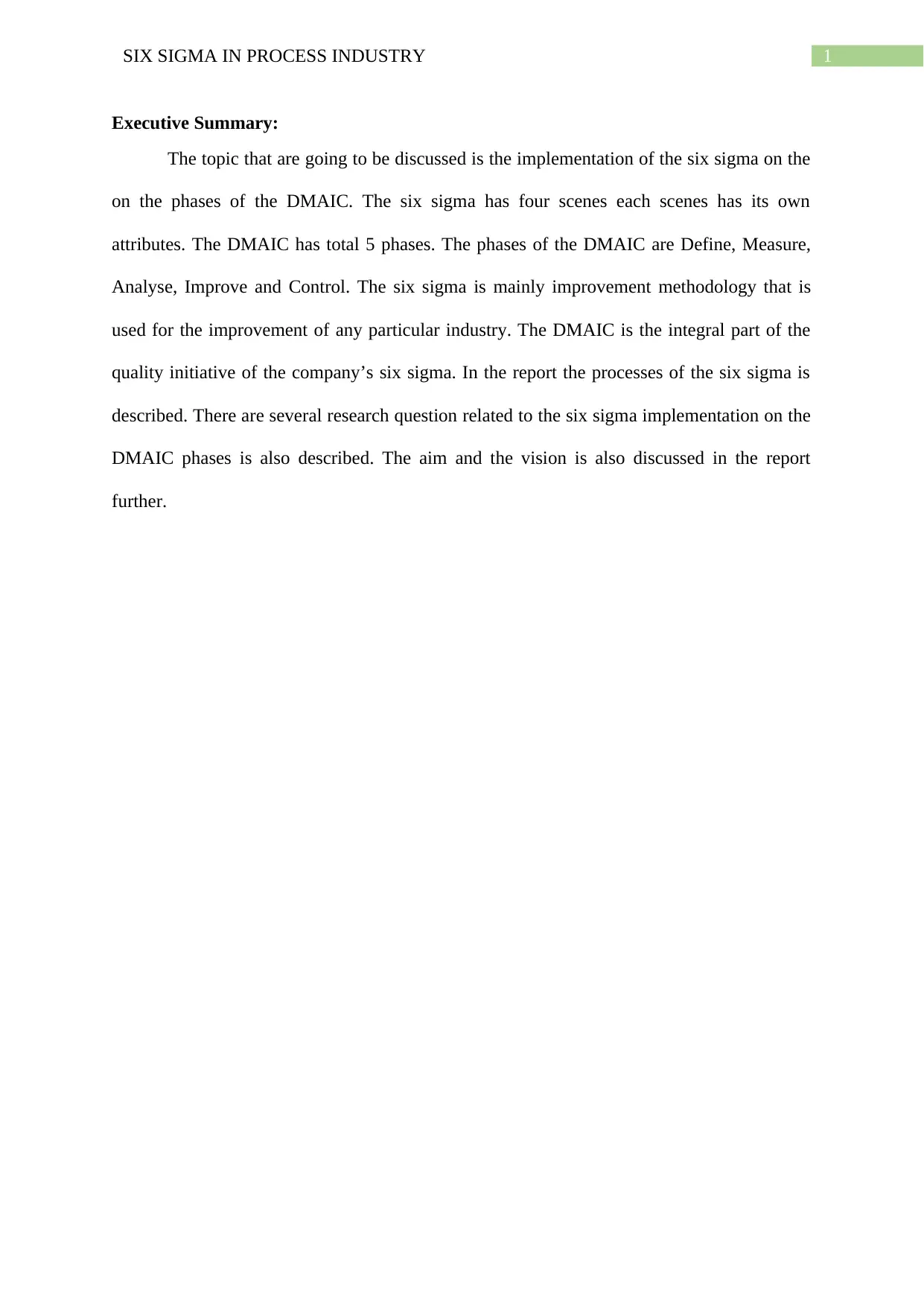
1SIX SIGMA IN PROCESS INDUSTRY
Executive Summary:
The topic that are going to be discussed is the implementation of the six sigma on the
on the phases of the DMAIC. The six sigma has four scenes each scenes has its own
attributes. The DMAIC has total 5 phases. The phases of the DMAIC are Define, Measure,
Analyse, Improve and Control. The six sigma is mainly improvement methodology that is
used for the improvement of any particular industry. The DMAIC is the integral part of the
quality initiative of the company’s six sigma. In the report the processes of the six sigma is
described. There are several research question related to the six sigma implementation on the
DMAIC phases is also described. The aim and the vision is also discussed in the report
further.
Executive Summary:
The topic that are going to be discussed is the implementation of the six sigma on the
on the phases of the DMAIC. The six sigma has four scenes each scenes has its own
attributes. The DMAIC has total 5 phases. The phases of the DMAIC are Define, Measure,
Analyse, Improve and Control. The six sigma is mainly improvement methodology that is
used for the improvement of any particular industry. The DMAIC is the integral part of the
quality initiative of the company’s six sigma. In the report the processes of the six sigma is
described. There are several research question related to the six sigma implementation on the
DMAIC phases is also described. The aim and the vision is also discussed in the report
further.
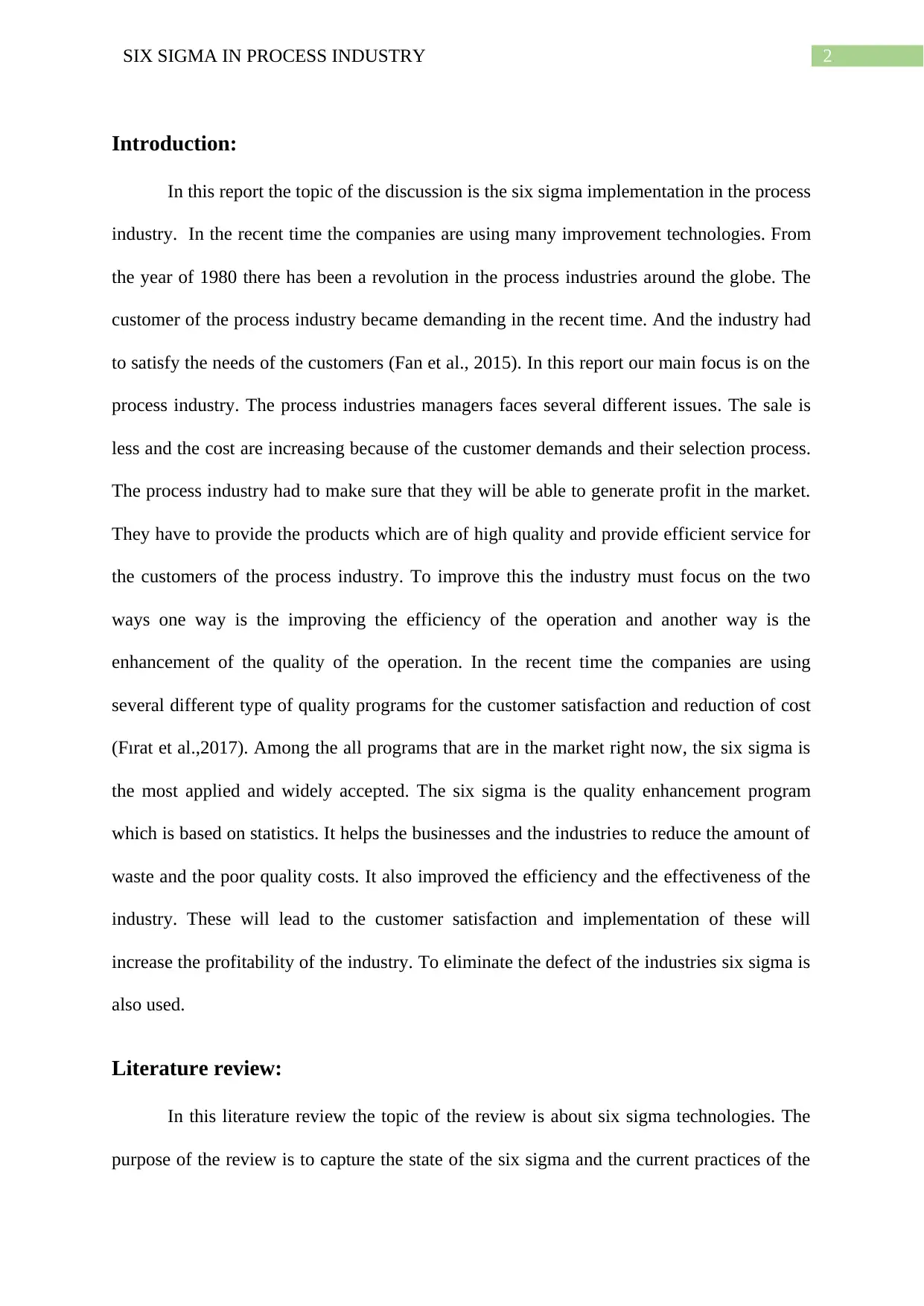
2SIX SIGMA IN PROCESS INDUSTRY
Introduction:
In this report the topic of the discussion is the six sigma implementation in the process
industry. In the recent time the companies are using many improvement technologies. From
the year of 1980 there has been a revolution in the process industries around the globe. The
customer of the process industry became demanding in the recent time. And the industry had
to satisfy the needs of the customers (Fan et al., 2015). In this report our main focus is on the
process industry. The process industries managers faces several different issues. The sale is
less and the cost are increasing because of the customer demands and their selection process.
The process industry had to make sure that they will be able to generate profit in the market.
They have to provide the products which are of high quality and provide efficient service for
the customers of the process industry. To improve this the industry must focus on the two
ways one way is the improving the efficiency of the operation and another way is the
enhancement of the quality of the operation. In the recent time the companies are using
several different type of quality programs for the customer satisfaction and reduction of cost
(Fırat et al.,2017). Among the all programs that are in the market right now, the six sigma is
the most applied and widely accepted. The six sigma is the quality enhancement program
which is based on statistics. It helps the businesses and the industries to reduce the amount of
waste and the poor quality costs. It also improved the efficiency and the effectiveness of the
industry. These will lead to the customer satisfaction and implementation of these will
increase the profitability of the industry. To eliminate the defect of the industries six sigma is
also used.
Literature review:
In this literature review the topic of the review is about six sigma technologies. The
purpose of the review is to capture the state of the six sigma and the current practices of the
Introduction:
In this report the topic of the discussion is the six sigma implementation in the process
industry. In the recent time the companies are using many improvement technologies. From
the year of 1980 there has been a revolution in the process industries around the globe. The
customer of the process industry became demanding in the recent time. And the industry had
to satisfy the needs of the customers (Fan et al., 2015). In this report our main focus is on the
process industry. The process industries managers faces several different issues. The sale is
less and the cost are increasing because of the customer demands and their selection process.
The process industry had to make sure that they will be able to generate profit in the market.
They have to provide the products which are of high quality and provide efficient service for
the customers of the process industry. To improve this the industry must focus on the two
ways one way is the improving the efficiency of the operation and another way is the
enhancement of the quality of the operation. In the recent time the companies are using
several different type of quality programs for the customer satisfaction and reduction of cost
(Fırat et al.,2017). Among the all programs that are in the market right now, the six sigma is
the most applied and widely accepted. The six sigma is the quality enhancement program
which is based on statistics. It helps the businesses and the industries to reduce the amount of
waste and the poor quality costs. It also improved the efficiency and the effectiveness of the
industry. These will lead to the customer satisfaction and implementation of these will
increase the profitability of the industry. To eliminate the defect of the industries six sigma is
also used.
Literature review:
In this literature review the topic of the review is about six sigma technologies. The
purpose of the review is to capture the state of the six sigma and the current practices of the
⊘ This is a preview!⊘
Do you want full access?
Subscribe today to unlock all pages.

Trusted by 1+ million students worldwide
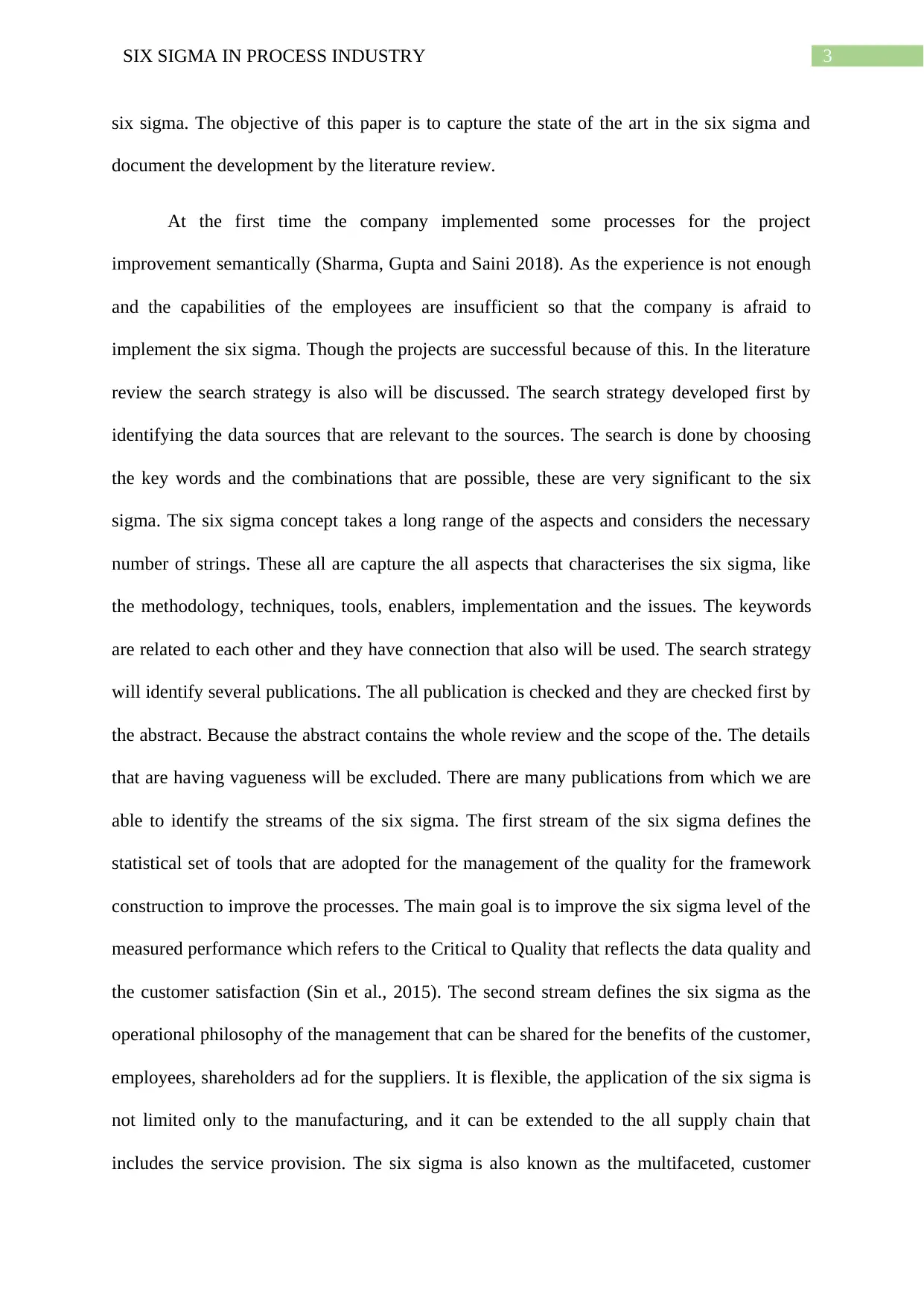
3SIX SIGMA IN PROCESS INDUSTRY
six sigma. The objective of this paper is to capture the state of the art in the six sigma and
document the development by the literature review.
At the first time the company implemented some processes for the project
improvement semantically (Sharma, Gupta and Saini 2018). As the experience is not enough
and the capabilities of the employees are insufficient so that the company is afraid to
implement the six sigma. Though the projects are successful because of this. In the literature
review the search strategy is also will be discussed. The search strategy developed first by
identifying the data sources that are relevant to the sources. The search is done by choosing
the key words and the combinations that are possible, these are very significant to the six
sigma. The six sigma concept takes a long range of the aspects and considers the necessary
number of strings. These all are capture the all aspects that characterises the six sigma, like
the methodology, techniques, tools, enablers, implementation and the issues. The keywords
are related to each other and they have connection that also will be used. The search strategy
will identify several publications. The all publication is checked and they are checked first by
the abstract. Because the abstract contains the whole review and the scope of the. The details
that are having vagueness will be excluded. There are many publications from which we are
able to identify the streams of the six sigma. The first stream of the six sigma defines the
statistical set of tools that are adopted for the management of the quality for the framework
construction to improve the processes. The main goal is to improve the six sigma level of the
measured performance which refers to the Critical to Quality that reflects the data quality and
the customer satisfaction (Sin et al., 2015). The second stream defines the six sigma as the
operational philosophy of the management that can be shared for the benefits of the customer,
employees, shareholders ad for the suppliers. It is flexible, the application of the six sigma is
not limited only to the manufacturing, and it can be extended to the all supply chain that
includes the service provision. The six sigma is also known as the multifaceted, customer
six sigma. The objective of this paper is to capture the state of the art in the six sigma and
document the development by the literature review.
At the first time the company implemented some processes for the project
improvement semantically (Sharma, Gupta and Saini 2018). As the experience is not enough
and the capabilities of the employees are insufficient so that the company is afraid to
implement the six sigma. Though the projects are successful because of this. In the literature
review the search strategy is also will be discussed. The search strategy developed first by
identifying the data sources that are relevant to the sources. The search is done by choosing
the key words and the combinations that are possible, these are very significant to the six
sigma. The six sigma concept takes a long range of the aspects and considers the necessary
number of strings. These all are capture the all aspects that characterises the six sigma, like
the methodology, techniques, tools, enablers, implementation and the issues. The keywords
are related to each other and they have connection that also will be used. The search strategy
will identify several publications. The all publication is checked and they are checked first by
the abstract. Because the abstract contains the whole review and the scope of the. The details
that are having vagueness will be excluded. There are many publications from which we are
able to identify the streams of the six sigma. The first stream of the six sigma defines the
statistical set of tools that are adopted for the management of the quality for the framework
construction to improve the processes. The main goal is to improve the six sigma level of the
measured performance which refers to the Critical to Quality that reflects the data quality and
the customer satisfaction (Sin et al., 2015). The second stream defines the six sigma as the
operational philosophy of the management that can be shared for the benefits of the customer,
employees, shareholders ad for the suppliers. It is flexible, the application of the six sigma is
not limited only to the manufacturing, and it can be extended to the all supply chain that
includes the service provision. The six sigma is also known as the multifaceted, customer
Paraphrase This Document
Need a fresh take? Get an instant paraphrase of this document with our AI Paraphraser
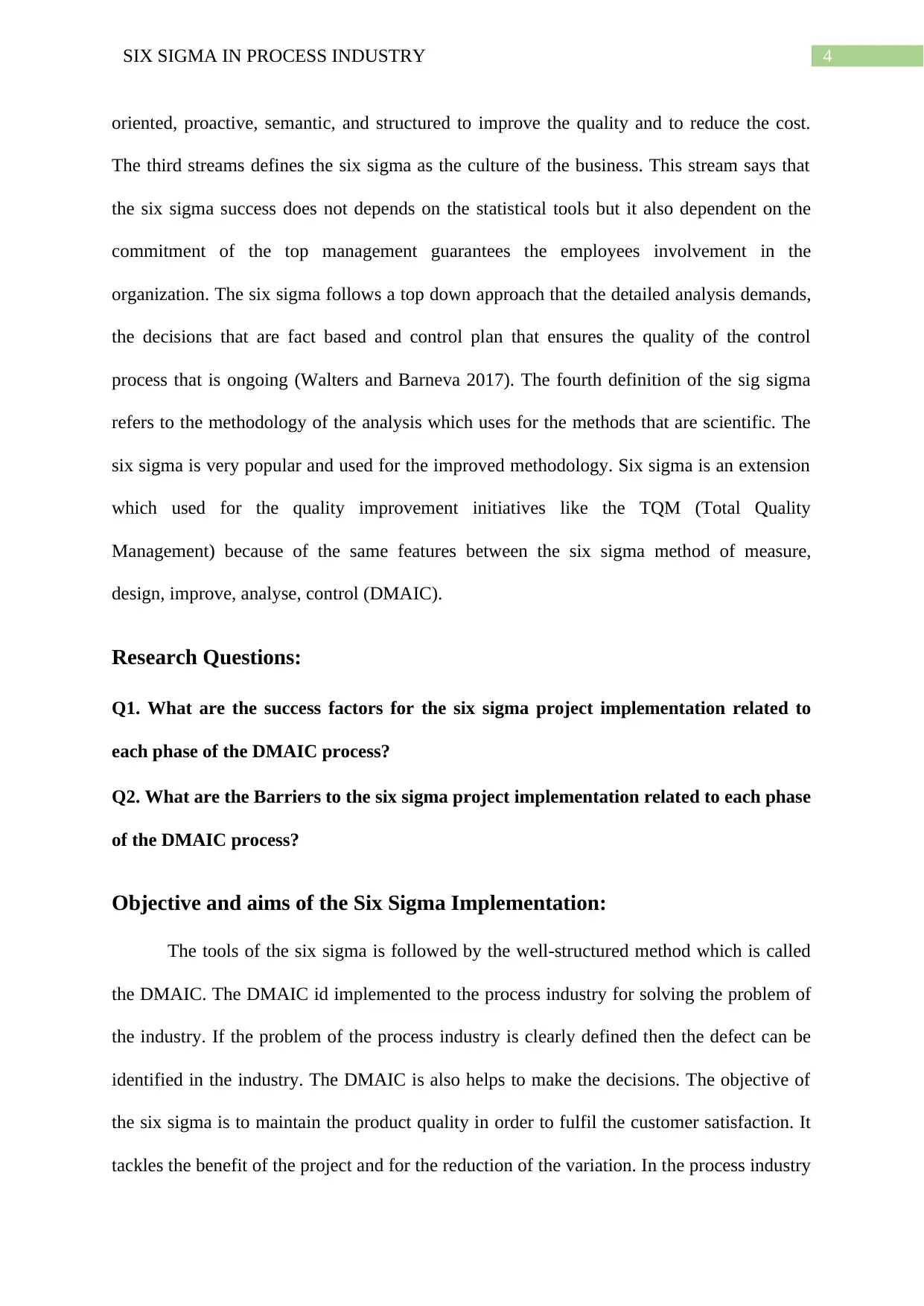
4SIX SIGMA IN PROCESS INDUSTRY
oriented, proactive, semantic, and structured to improve the quality and to reduce the cost.
The third streams defines the six sigma as the culture of the business. This stream says that
the six sigma success does not depends on the statistical tools but it also dependent on the
commitment of the top management guarantees the employees involvement in the
organization. The six sigma follows a top down approach that the detailed analysis demands,
the decisions that are fact based and control plan that ensures the quality of the control
process that is ongoing (Walters and Barneva 2017). The fourth definition of the sig sigma
refers to the methodology of the analysis which uses for the methods that are scientific. The
six sigma is very popular and used for the improved methodology. Six sigma is an extension
which used for the quality improvement initiatives like the TQM (Total Quality
Management) because of the same features between the six sigma method of measure,
design, improve, analyse, control (DMAIC).
Research Questions:
Q1. What are the success factors for the six sigma project implementation related to
each phase of the DMAIC process?
Q2. What are the Barriers to the six sigma project implementation related to each phase
of the DMAIC process?
Objective and aims of the Six Sigma Implementation:
The tools of the six sigma is followed by the well-structured method which is called
the DMAIC. The DMAIC id implemented to the process industry for solving the problem of
the industry. If the problem of the process industry is clearly defined then the defect can be
identified in the industry. The DMAIC is also helps to make the decisions. The objective of
the six sigma is to maintain the product quality in order to fulfil the customer satisfaction. It
tackles the benefit of the project and for the reduction of the variation. In the process industry
oriented, proactive, semantic, and structured to improve the quality and to reduce the cost.
The third streams defines the six sigma as the culture of the business. This stream says that
the six sigma success does not depends on the statistical tools but it also dependent on the
commitment of the top management guarantees the employees involvement in the
organization. The six sigma follows a top down approach that the detailed analysis demands,
the decisions that are fact based and control plan that ensures the quality of the control
process that is ongoing (Walters and Barneva 2017). The fourth definition of the sig sigma
refers to the methodology of the analysis which uses for the methods that are scientific. The
six sigma is very popular and used for the improved methodology. Six sigma is an extension
which used for the quality improvement initiatives like the TQM (Total Quality
Management) because of the same features between the six sigma method of measure,
design, improve, analyse, control (DMAIC).
Research Questions:
Q1. What are the success factors for the six sigma project implementation related to
each phase of the DMAIC process?
Q2. What are the Barriers to the six sigma project implementation related to each phase
of the DMAIC process?
Objective and aims of the Six Sigma Implementation:
The tools of the six sigma is followed by the well-structured method which is called
the DMAIC. The DMAIC id implemented to the process industry for solving the problem of
the industry. If the problem of the process industry is clearly defined then the defect can be
identified in the industry. The DMAIC is also helps to make the decisions. The objective of
the six sigma is to maintain the product quality in order to fulfil the customer satisfaction. It
tackles the benefit of the project and for the reduction of the variation. In the process industry
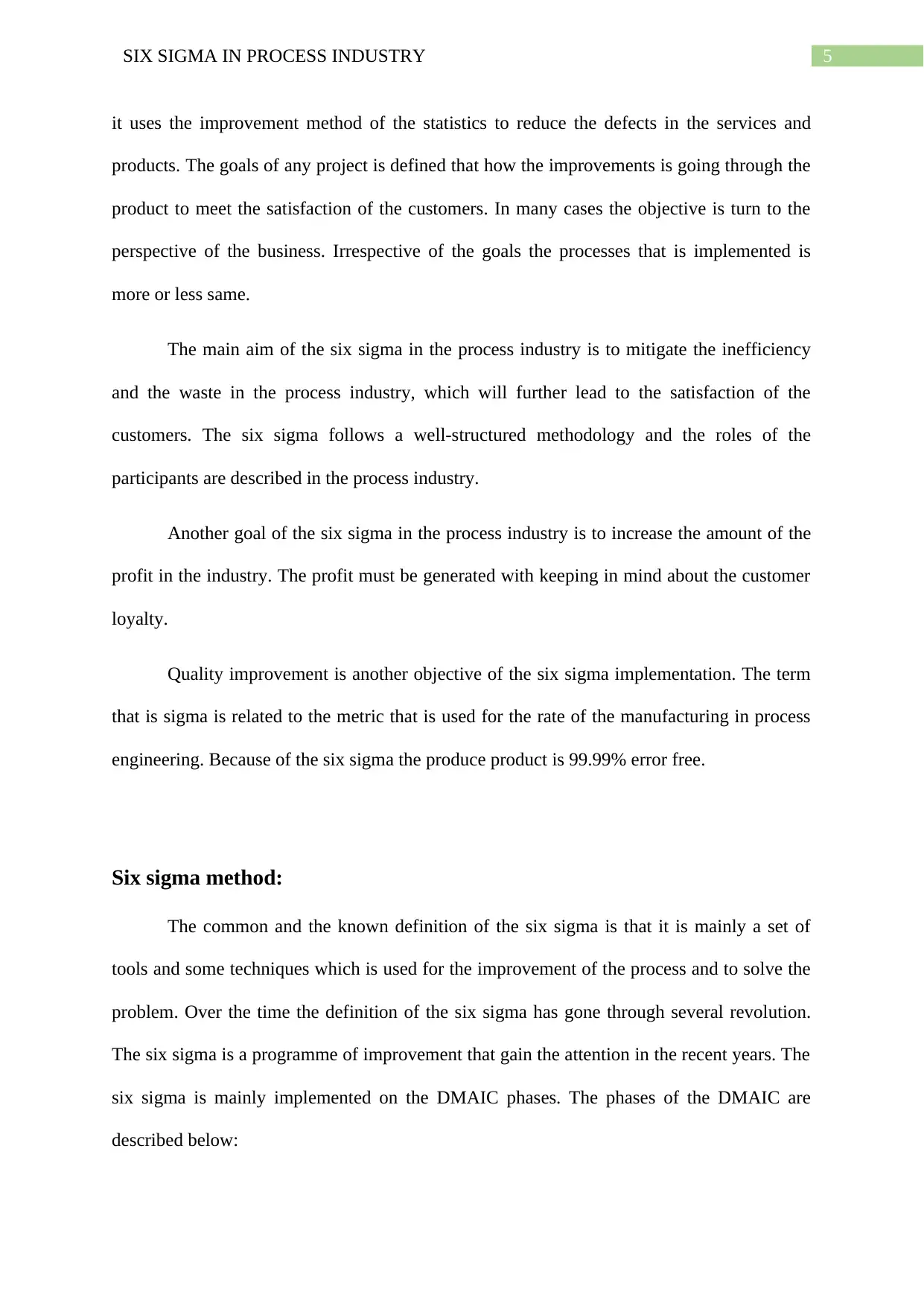
5SIX SIGMA IN PROCESS INDUSTRY
it uses the improvement method of the statistics to reduce the defects in the services and
products. The goals of any project is defined that how the improvements is going through the
product to meet the satisfaction of the customers. In many cases the objective is turn to the
perspective of the business. Irrespective of the goals the processes that is implemented is
more or less same.
The main aim of the six sigma in the process industry is to mitigate the inefficiency
and the waste in the process industry, which will further lead to the satisfaction of the
customers. The six sigma follows a well-structured methodology and the roles of the
participants are described in the process industry.
Another goal of the six sigma in the process industry is to increase the amount of the
profit in the industry. The profit must be generated with keeping in mind about the customer
loyalty.
Quality improvement is another objective of the six sigma implementation. The term
that is sigma is related to the metric that is used for the rate of the manufacturing in process
engineering. Because of the six sigma the produce product is 99.99% error free.
Six sigma method:
The common and the known definition of the six sigma is that it is mainly a set of
tools and some techniques which is used for the improvement of the process and to solve the
problem. Over the time the definition of the six sigma has gone through several revolution.
The six sigma is a programme of improvement that gain the attention in the recent years. The
six sigma is mainly implemented on the DMAIC phases. The phases of the DMAIC are
described below:
it uses the improvement method of the statistics to reduce the defects in the services and
products. The goals of any project is defined that how the improvements is going through the
product to meet the satisfaction of the customers. In many cases the objective is turn to the
perspective of the business. Irrespective of the goals the processes that is implemented is
more or less same.
The main aim of the six sigma in the process industry is to mitigate the inefficiency
and the waste in the process industry, which will further lead to the satisfaction of the
customers. The six sigma follows a well-structured methodology and the roles of the
participants are described in the process industry.
Another goal of the six sigma in the process industry is to increase the amount of the
profit in the industry. The profit must be generated with keeping in mind about the customer
loyalty.
Quality improvement is another objective of the six sigma implementation. The term
that is sigma is related to the metric that is used for the rate of the manufacturing in process
engineering. Because of the six sigma the produce product is 99.99% error free.
Six sigma method:
The common and the known definition of the six sigma is that it is mainly a set of
tools and some techniques which is used for the improvement of the process and to solve the
problem. Over the time the definition of the six sigma has gone through several revolution.
The six sigma is a programme of improvement that gain the attention in the recent years. The
six sigma is mainly implemented on the DMAIC phases. The phases of the DMAIC are
described below:
⊘ This is a preview!⊘
Do you want full access?
Subscribe today to unlock all pages.

Trusted by 1+ million students worldwide
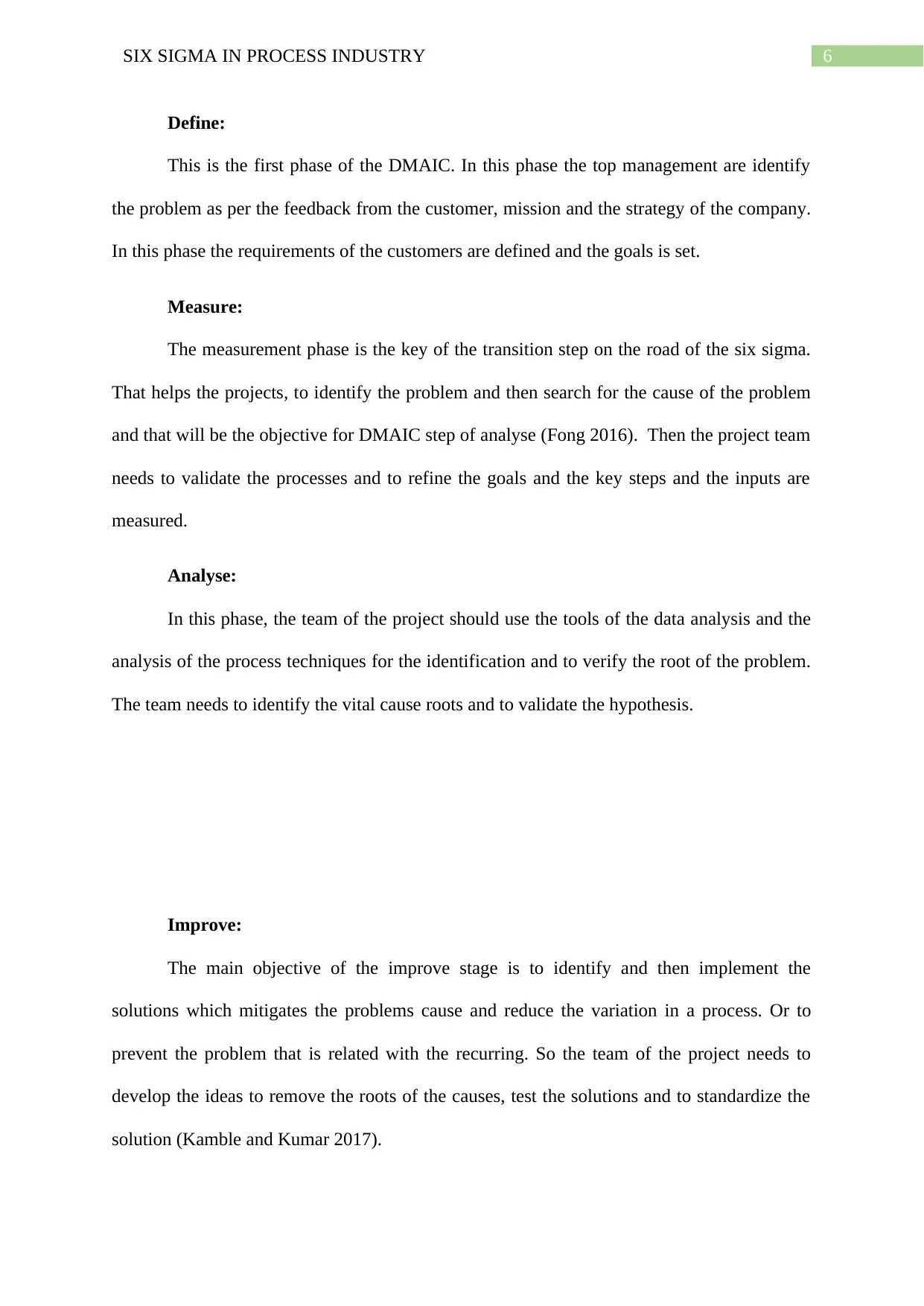
6SIX SIGMA IN PROCESS INDUSTRY
Define:
This is the first phase of the DMAIC. In this phase the top management are identify
the problem as per the feedback from the customer, mission and the strategy of the company.
In this phase the requirements of the customers are defined and the goals is set.
Measure:
The measurement phase is the key of the transition step on the road of the six sigma.
That helps the projects, to identify the problem and then search for the cause of the problem
and that will be the objective for DMAIC step of analyse (Fong 2016). Then the project team
needs to validate the processes and to refine the goals and the key steps and the inputs are
measured.
Analyse:
In this phase, the team of the project should use the tools of the data analysis and the
analysis of the process techniques for the identification and to verify the root of the problem.
The team needs to identify the vital cause roots and to validate the hypothesis.
Improve:
The main objective of the improve stage is to identify and then implement the
solutions which mitigates the problems cause and reduce the variation in a process. Or to
prevent the problem that is related with the recurring. So the team of the project needs to
develop the ideas to remove the roots of the causes, test the solutions and to standardize the
solution (Kamble and Kumar 2017).
Define:
This is the first phase of the DMAIC. In this phase the top management are identify
the problem as per the feedback from the customer, mission and the strategy of the company.
In this phase the requirements of the customers are defined and the goals is set.
Measure:
The measurement phase is the key of the transition step on the road of the six sigma.
That helps the projects, to identify the problem and then search for the cause of the problem
and that will be the objective for DMAIC step of analyse (Fong 2016). Then the project team
needs to validate the processes and to refine the goals and the key steps and the inputs are
measured.
Analyse:
In this phase, the team of the project should use the tools of the data analysis and the
analysis of the process techniques for the identification and to verify the root of the problem.
The team needs to identify the vital cause roots and to validate the hypothesis.
Improve:
The main objective of the improve stage is to identify and then implement the
solutions which mitigates the problems cause and reduce the variation in a process. Or to
prevent the problem that is related with the recurring. So the team of the project needs to
develop the ideas to remove the roots of the causes, test the solutions and to standardize the
solution (Kamble and Kumar 2017).
Paraphrase This Document
Need a fresh take? Get an instant paraphrase of this document with our AI Paraphraser
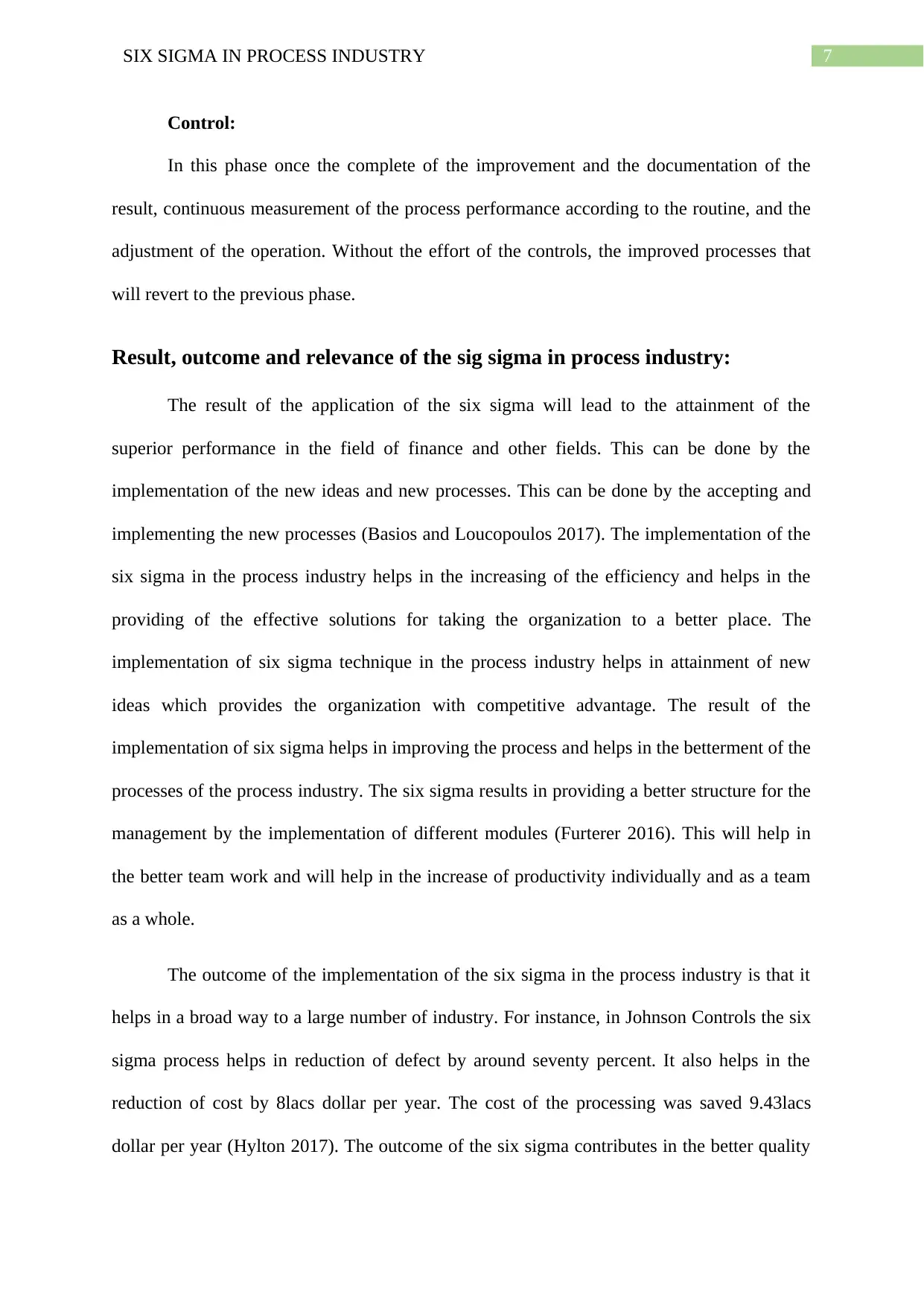
7SIX SIGMA IN PROCESS INDUSTRY
Control:
In this phase once the complete of the improvement and the documentation of the
result, continuous measurement of the process performance according to the routine, and the
adjustment of the operation. Without the effort of the controls, the improved processes that
will revert to the previous phase.
Result, outcome and relevance of the sig sigma in process industry:
The result of the application of the six sigma will lead to the attainment of the
superior performance in the field of finance and other fields. This can be done by the
implementation of the new ideas and new processes. This can be done by the accepting and
implementing the new processes (Basios and Loucopoulos 2017). The implementation of the
six sigma in the process industry helps in the increasing of the efficiency and helps in the
providing of the effective solutions for taking the organization to a better place. The
implementation of six sigma technique in the process industry helps in attainment of new
ideas which provides the organization with competitive advantage. The result of the
implementation of six sigma helps in improving the process and helps in the betterment of the
processes of the process industry. The six sigma results in providing a better structure for the
management by the implementation of different modules (Furterer 2016). This will help in
the better team work and will help in the increase of productivity individually and as a team
as a whole.
The outcome of the implementation of the six sigma in the process industry is that it
helps in a broad way to a large number of industry. For instance, in Johnson Controls the six
sigma process helps in reduction of defect by around seventy percent. It also helps in the
reduction of cost by 8lacs dollar per year. The cost of the processing was saved 9.43lacs
dollar per year (Hylton 2017). The outcome of the six sigma contributes in the better quality
Control:
In this phase once the complete of the improvement and the documentation of the
result, continuous measurement of the process performance according to the routine, and the
adjustment of the operation. Without the effort of the controls, the improved processes that
will revert to the previous phase.
Result, outcome and relevance of the sig sigma in process industry:
The result of the application of the six sigma will lead to the attainment of the
superior performance in the field of finance and other fields. This can be done by the
implementation of the new ideas and new processes. This can be done by the accepting and
implementing the new processes (Basios and Loucopoulos 2017). The implementation of the
six sigma in the process industry helps in the increasing of the efficiency and helps in the
providing of the effective solutions for taking the organization to a better place. The
implementation of six sigma technique in the process industry helps in attainment of new
ideas which provides the organization with competitive advantage. The result of the
implementation of six sigma helps in improving the process and helps in the betterment of the
processes of the process industry. The six sigma results in providing a better structure for the
management by the implementation of different modules (Furterer 2016). This will help in
the better team work and will help in the increase of productivity individually and as a team
as a whole.
The outcome of the implementation of the six sigma in the process industry is that it
helps in a broad way to a large number of industry. For instance, in Johnson Controls the six
sigma process helps in reduction of defect by around seventy percent. It also helps in the
reduction of cost by 8lacs dollar per year. The cost of the processing was saved 9.43lacs
dollar per year (Hylton 2017). The outcome of the six sigma contributes in the better quality
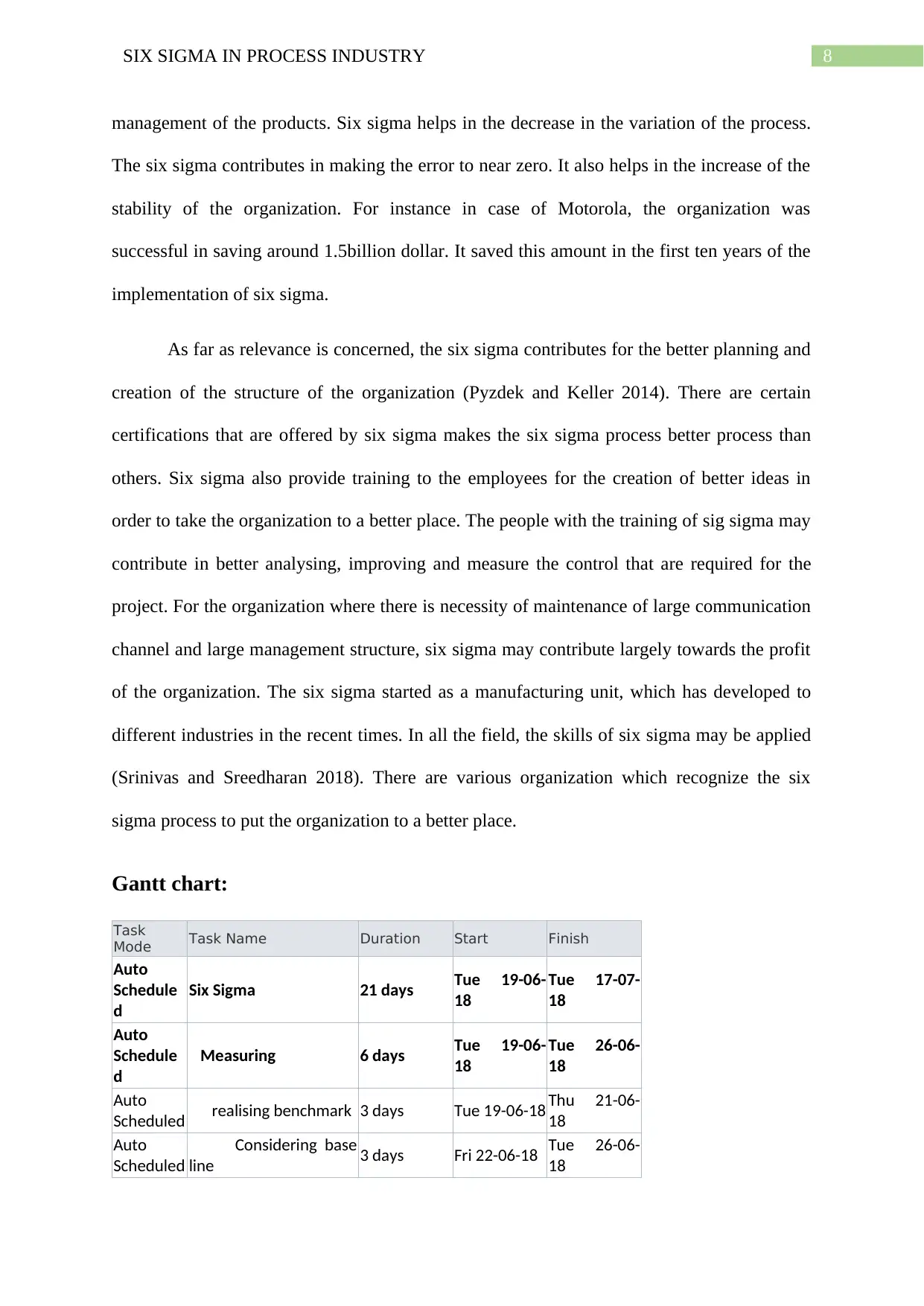
8SIX SIGMA IN PROCESS INDUSTRY
management of the products. Six sigma helps in the decrease in the variation of the process.
The six sigma contributes in making the error to near zero. It also helps in the increase of the
stability of the organization. For instance in case of Motorola, the organization was
successful in saving around 1.5billion dollar. It saved this amount in the first ten years of the
implementation of six sigma.
As far as relevance is concerned, the six sigma contributes for the better planning and
creation of the structure of the organization (Pyzdek and Keller 2014). There are certain
certifications that are offered by six sigma makes the six sigma process better process than
others. Six sigma also provide training to the employees for the creation of better ideas in
order to take the organization to a better place. The people with the training of sig sigma may
contribute in better analysing, improving and measure the control that are required for the
project. For the organization where there is necessity of maintenance of large communication
channel and large management structure, six sigma may contribute largely towards the profit
of the organization. The six sigma started as a manufacturing unit, which has developed to
different industries in the recent times. In all the field, the skills of six sigma may be applied
(Srinivas and Sreedharan 2018). There are various organization which recognize the six
sigma process to put the organization to a better place.
Gantt chart:
Task
Mode Task Name Duration Start Finish
Auto
Schedule
d
Six Sigma 21 days Tue 19-06-
18
Tue 17-07-
18
Auto
Schedule
d
Measuring 6 days Tue 19-06-
18
Tue 26-06-
18
Auto
Scheduled realising benchmark 3 days Tue 19-06-18 Thu 21-06-
18
Auto
Scheduled
Considering base
line 3 days Fri 22-06-18 Tue 26-06-
18
management of the products. Six sigma helps in the decrease in the variation of the process.
The six sigma contributes in making the error to near zero. It also helps in the increase of the
stability of the organization. For instance in case of Motorola, the organization was
successful in saving around 1.5billion dollar. It saved this amount in the first ten years of the
implementation of six sigma.
As far as relevance is concerned, the six sigma contributes for the better planning and
creation of the structure of the organization (Pyzdek and Keller 2014). There are certain
certifications that are offered by six sigma makes the six sigma process better process than
others. Six sigma also provide training to the employees for the creation of better ideas in
order to take the organization to a better place. The people with the training of sig sigma may
contribute in better analysing, improving and measure the control that are required for the
project. For the organization where there is necessity of maintenance of large communication
channel and large management structure, six sigma may contribute largely towards the profit
of the organization. The six sigma started as a manufacturing unit, which has developed to
different industries in the recent times. In all the field, the skills of six sigma may be applied
(Srinivas and Sreedharan 2018). There are various organization which recognize the six
sigma process to put the organization to a better place.
Gantt chart:
Task
Mode Task Name Duration Start Finish
Auto
Schedule
d
Six Sigma 21 days Tue 19-06-
18
Tue 17-07-
18
Auto
Schedule
d
Measuring 6 days Tue 19-06-
18
Tue 26-06-
18
Auto
Scheduled realising benchmark 3 days Tue 19-06-18 Thu 21-06-
18
Auto
Scheduled
Considering base
line 3 days Fri 22-06-18 Tue 26-06-
18
⊘ This is a preview!⊘
Do you want full access?
Subscribe today to unlock all pages.

Trusted by 1+ million students worldwide
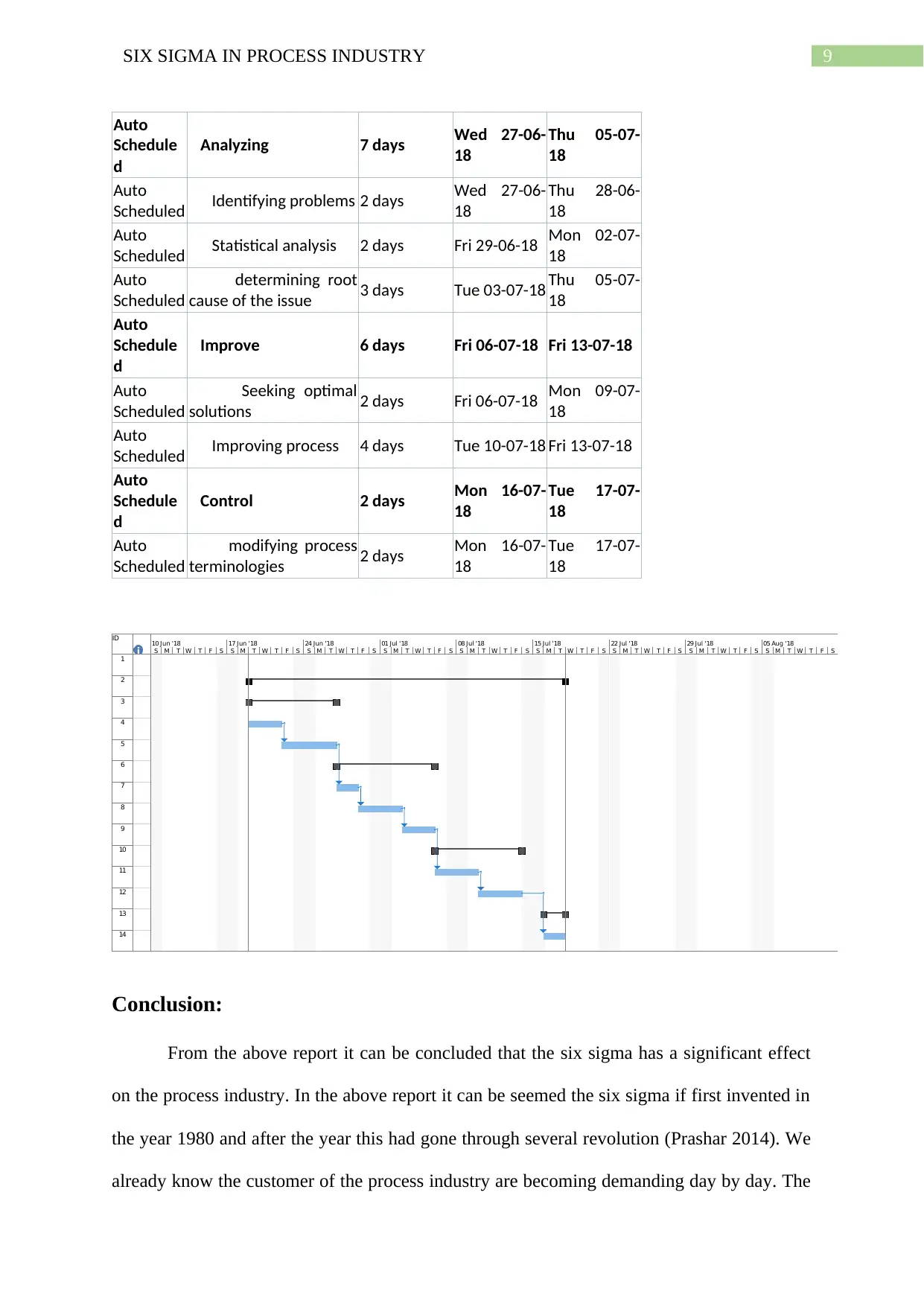
9SIX SIGMA IN PROCESS INDUSTRY
Auto
Schedule
d
Analyzing 7 days Wed 27-06-
18
Thu 05-07-
18
Auto
Scheduled Identifying problems 2 days Wed 27-06-
18
Thu 28-06-
18
Auto
Scheduled Statistical analysis 2 days Fri 29-06-18 Mon 02-07-
18
Auto
Scheduled
determining root
cause of the issue 3 days Tue 03-07-18 Thu 05-07-
18
Auto
Schedule
d
Improve 6 days Fri 06-07-18 Fri 13-07-18
Auto
Scheduled
Seeking optimal
solutions 2 days Fri 06-07-18 Mon 09-07-
18
Auto
Scheduled Improving process 4 days Tue 10-07-18 Fri 13-07-18
Auto
Schedule
d
Control 2 days Mon 16-07-
18
Tue 17-07-
18
Auto
Scheduled
modifying process
terminologies 2 days Mon 16-07-
18
Tue 17-07-
18
ID
1
2
3
4
5
6
7
8
9
10
11
12
13
14
S M T W T F S S M T W T F S S M T W T F S S M T W T F S S M T W T F S S M T W T F S S M T W T F S S M T W T F S S M T W T F S
10 Jun '18 17 Jun '18 24 Jun '18 01 Jul '18 08 Jul '18 15 Jul '18 22 Jul '18 29 Jul '18 05 Aug '18
Conclusion:
From the above report it can be concluded that the six sigma has a significant effect
on the process industry. In the above report it can be seemed the six sigma if first invented in
the year 1980 and after the year this had gone through several revolution (Prashar 2014). We
already know the customer of the process industry are becoming demanding day by day. The
Auto
Schedule
d
Analyzing 7 days Wed 27-06-
18
Thu 05-07-
18
Auto
Scheduled Identifying problems 2 days Wed 27-06-
18
Thu 28-06-
18
Auto
Scheduled Statistical analysis 2 days Fri 29-06-18 Mon 02-07-
18
Auto
Scheduled
determining root
cause of the issue 3 days Tue 03-07-18 Thu 05-07-
18
Auto
Schedule
d
Improve 6 days Fri 06-07-18 Fri 13-07-18
Auto
Scheduled
Seeking optimal
solutions 2 days Fri 06-07-18 Mon 09-07-
18
Auto
Scheduled Improving process 4 days Tue 10-07-18 Fri 13-07-18
Auto
Schedule
d
Control 2 days Mon 16-07-
18
Tue 17-07-
18
Auto
Scheduled
modifying process
terminologies 2 days Mon 16-07-
18
Tue 17-07-
18
ID
1
2
3
4
5
6
7
8
9
10
11
12
13
14
S M T W T F S S M T W T F S S M T W T F S S M T W T F S S M T W T F S S M T W T F S S M T W T F S S M T W T F S S M T W T F S
10 Jun '18 17 Jun '18 24 Jun '18 01 Jul '18 08 Jul '18 15 Jul '18 22 Jul '18 29 Jul '18 05 Aug '18
Conclusion:
From the above report it can be concluded that the six sigma has a significant effect
on the process industry. In the above report it can be seemed the six sigma if first invented in
the year 1980 and after the year this had gone through several revolution (Prashar 2014). We
already know the customer of the process industry are becoming demanding day by day. The
Paraphrase This Document
Need a fresh take? Get an instant paraphrase of this document with our AI Paraphraser
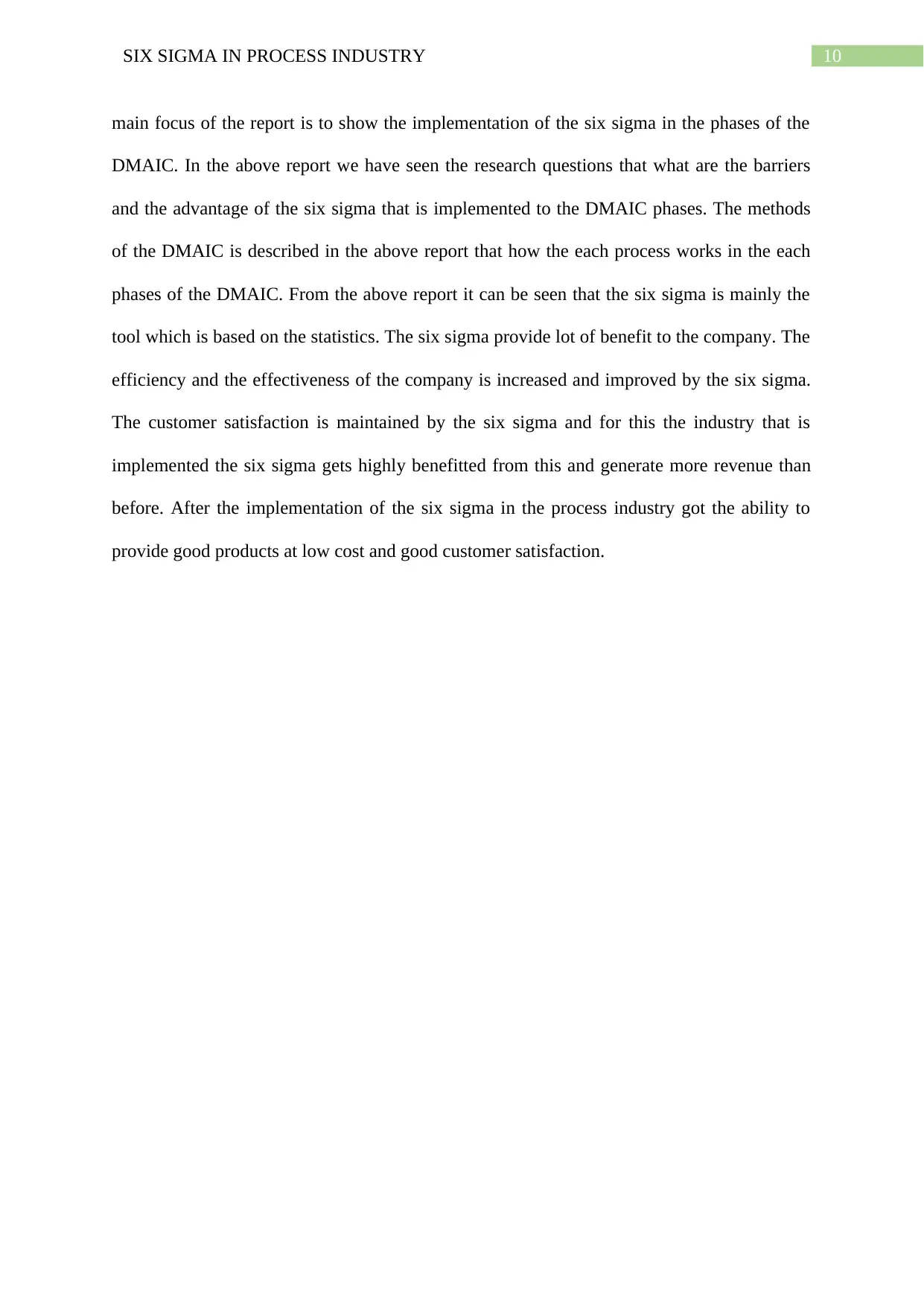
10SIX SIGMA IN PROCESS INDUSTRY
main focus of the report is to show the implementation of the six sigma in the phases of the
DMAIC. In the above report we have seen the research questions that what are the barriers
and the advantage of the six sigma that is implemented to the DMAIC phases. The methods
of the DMAIC is described in the above report that how the each process works in the each
phases of the DMAIC. From the above report it can be seen that the six sigma is mainly the
tool which is based on the statistics. The six sigma provide lot of benefit to the company. The
efficiency and the effectiveness of the company is increased and improved by the six sigma.
The customer satisfaction is maintained by the six sigma and for this the industry that is
implemented the six sigma gets highly benefitted from this and generate more revenue than
before. After the implementation of the six sigma in the process industry got the ability to
provide good products at low cost and good customer satisfaction.
main focus of the report is to show the implementation of the six sigma in the phases of the
DMAIC. In the above report we have seen the research questions that what are the barriers
and the advantage of the six sigma that is implemented to the DMAIC phases. The methods
of the DMAIC is described in the above report that how the each process works in the each
phases of the DMAIC. From the above report it can be seen that the six sigma is mainly the
tool which is based on the statistics. The six sigma provide lot of benefit to the company. The
efficiency and the effectiveness of the company is increased and improved by the six sigma.
The customer satisfaction is maintained by the six sigma and for this the industry that is
implemented the six sigma gets highly benefitted from this and generate more revenue than
before. After the implementation of the six sigma in the process industry got the ability to
provide good products at low cost and good customer satisfaction.
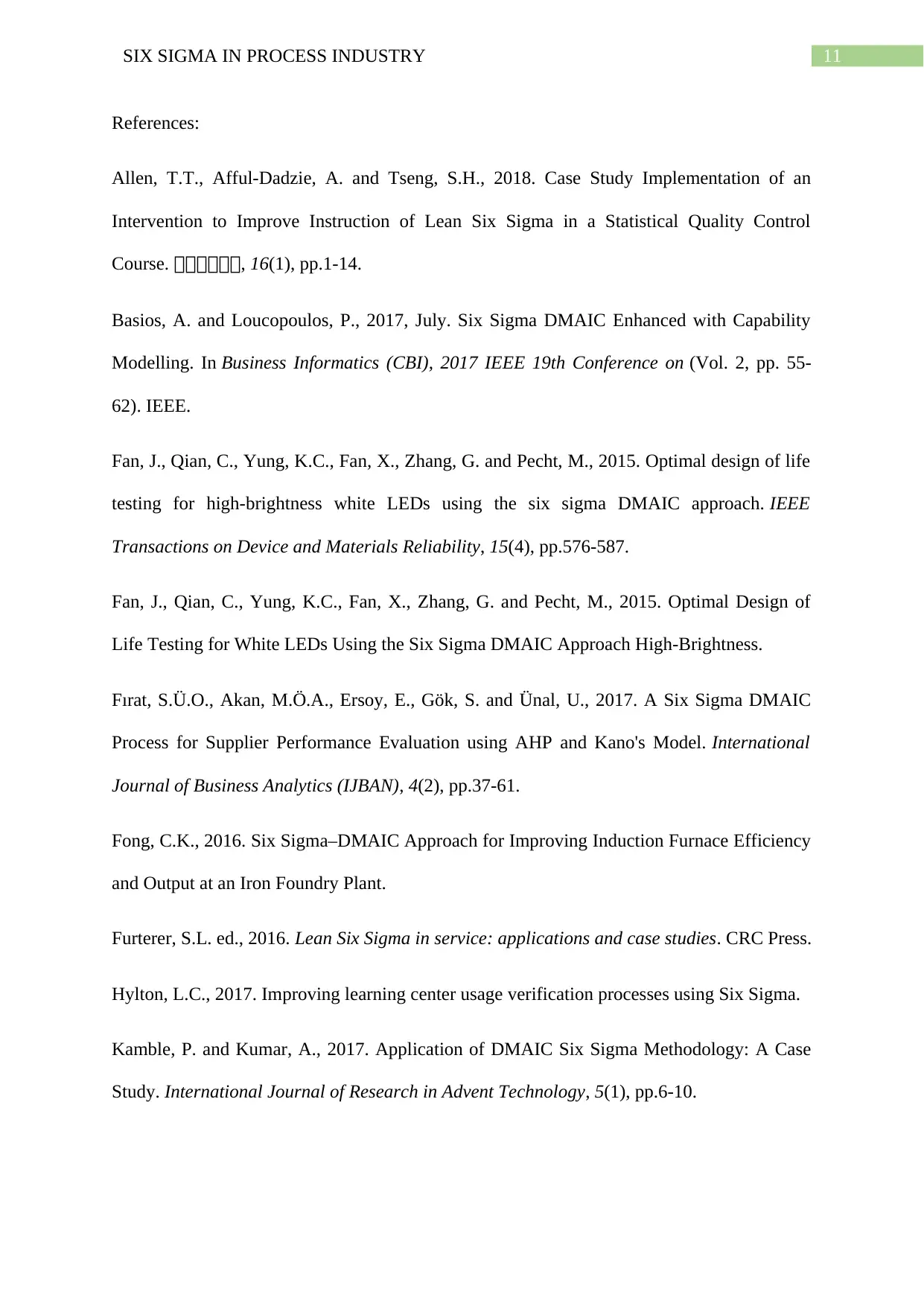
11SIX SIGMA IN PROCESS INDUSTRY
References:
Allen, T.T., Afful-Dadzie, A. and Tseng, S.H., 2018. Case Study Implementation of an
Intervention to Improve Instruction of Lean Six Sigma in a Statistical Quality Control
Course. 中中中中中中, 16(1), pp.1-14.
Basios, A. and Loucopoulos, P., 2017, July. Six Sigma DMAIC Enhanced with Capability
Modelling. In Business Informatics (CBI), 2017 IEEE 19th Conference on (Vol. 2, pp. 55-
62). IEEE.
Fan, J., Qian, C., Yung, K.C., Fan, X., Zhang, G. and Pecht, M., 2015. Optimal design of life
testing for high-brightness white LEDs using the six sigma DMAIC approach. IEEE
Transactions on Device and Materials Reliability, 15(4), pp.576-587.
Fan, J., Qian, C., Yung, K.C., Fan, X., Zhang, G. and Pecht, M., 2015. Optimal Design of
Life Testing for White LEDs Using the Six Sigma DMAIC Approach High-Brightness.
Fırat, S.Ü.O., Akan, M.Ö.A., Ersoy, E., Gök, S. and Ünal, U., 2017. A Six Sigma DMAIC
Process for Supplier Performance Evaluation using AHP and Kano's Model. International
Journal of Business Analytics (IJBAN), 4(2), pp.37-61.
Fong, C.K., 2016. Six Sigma–DMAIC Approach for Improving Induction Furnace Efficiency
and Output at an Iron Foundry Plant.
Furterer, S.L. ed., 2016. Lean Six Sigma in service: applications and case studies. CRC Press.
Hylton, L.C., 2017. Improving learning center usage verification processes using Six Sigma.
Kamble, P. and Kumar, A., 2017. Application of DMAIC Six Sigma Methodology: A Case
Study. International Journal of Research in Advent Technology, 5(1), pp.6-10.
References:
Allen, T.T., Afful-Dadzie, A. and Tseng, S.H., 2018. Case Study Implementation of an
Intervention to Improve Instruction of Lean Six Sigma in a Statistical Quality Control
Course. 中中中中中中, 16(1), pp.1-14.
Basios, A. and Loucopoulos, P., 2017, July. Six Sigma DMAIC Enhanced with Capability
Modelling. In Business Informatics (CBI), 2017 IEEE 19th Conference on (Vol. 2, pp. 55-
62). IEEE.
Fan, J., Qian, C., Yung, K.C., Fan, X., Zhang, G. and Pecht, M., 2015. Optimal design of life
testing for high-brightness white LEDs using the six sigma DMAIC approach. IEEE
Transactions on Device and Materials Reliability, 15(4), pp.576-587.
Fan, J., Qian, C., Yung, K.C., Fan, X., Zhang, G. and Pecht, M., 2015. Optimal Design of
Life Testing for White LEDs Using the Six Sigma DMAIC Approach High-Brightness.
Fırat, S.Ü.O., Akan, M.Ö.A., Ersoy, E., Gök, S. and Ünal, U., 2017. A Six Sigma DMAIC
Process for Supplier Performance Evaluation using AHP and Kano's Model. International
Journal of Business Analytics (IJBAN), 4(2), pp.37-61.
Fong, C.K., 2016. Six Sigma–DMAIC Approach for Improving Induction Furnace Efficiency
and Output at an Iron Foundry Plant.
Furterer, S.L. ed., 2016. Lean Six Sigma in service: applications and case studies. CRC Press.
Hylton, L.C., 2017. Improving learning center usage verification processes using Six Sigma.
Kamble, P. and Kumar, A., 2017. Application of DMAIC Six Sigma Methodology: A Case
Study. International Journal of Research in Advent Technology, 5(1), pp.6-10.
⊘ This is a preview!⊘
Do you want full access?
Subscribe today to unlock all pages.

Trusted by 1+ million students worldwide
1 out of 13
Related Documents
Your All-in-One AI-Powered Toolkit for Academic Success.
+13062052269
info@desklib.com
Available 24*7 on WhatsApp / Email
![[object Object]](/_next/static/media/star-bottom.7253800d.svg)
Unlock your academic potential
Copyright © 2020–2025 A2Z Services. All Rights Reserved. Developed and managed by ZUCOL.




